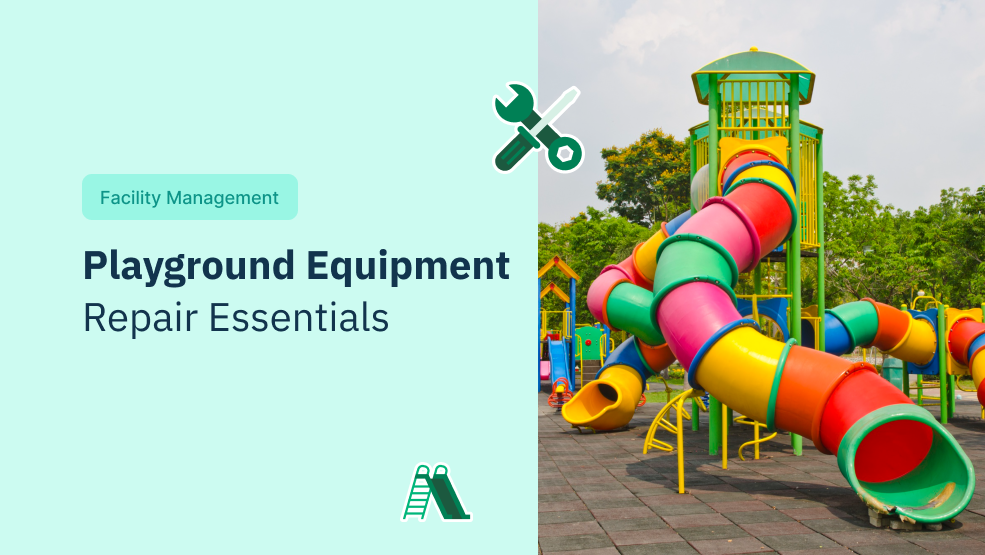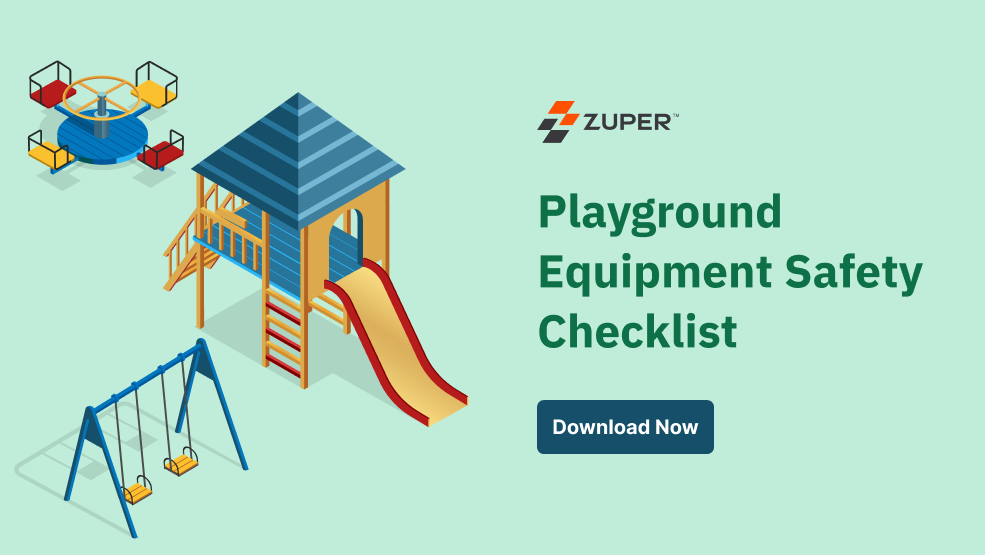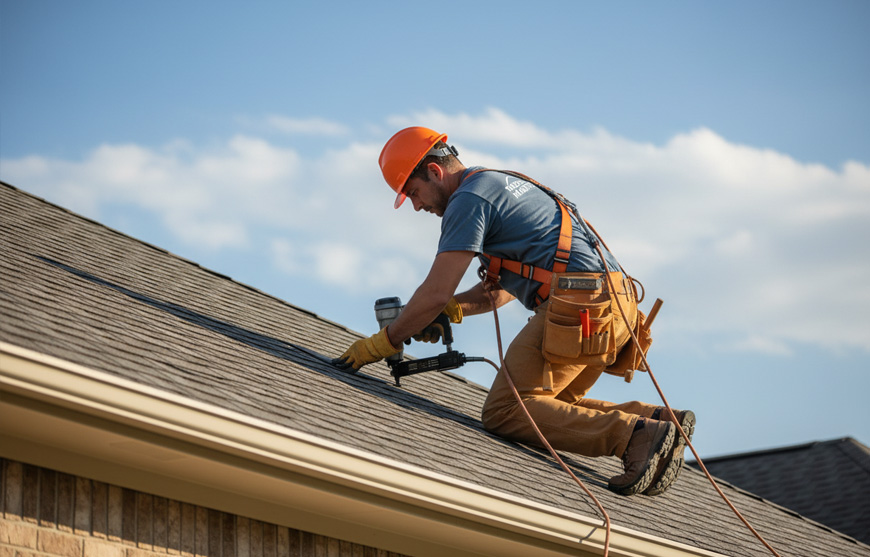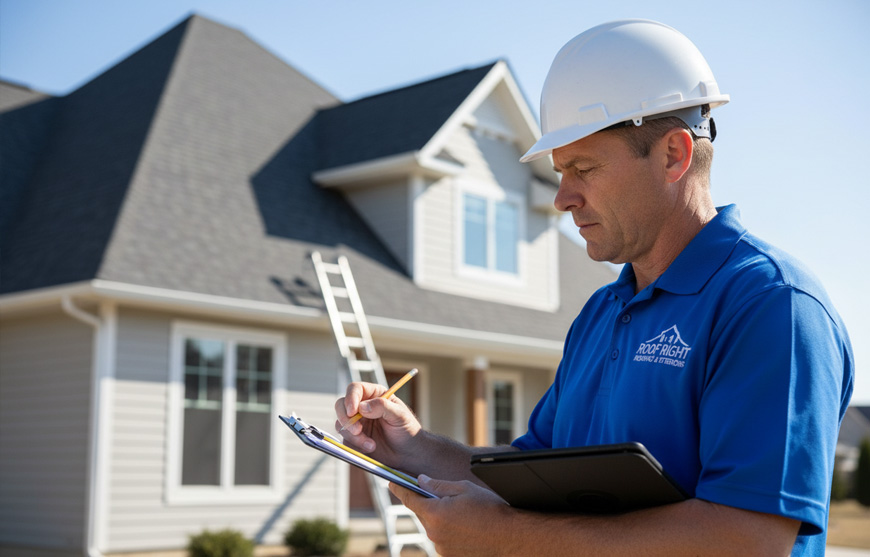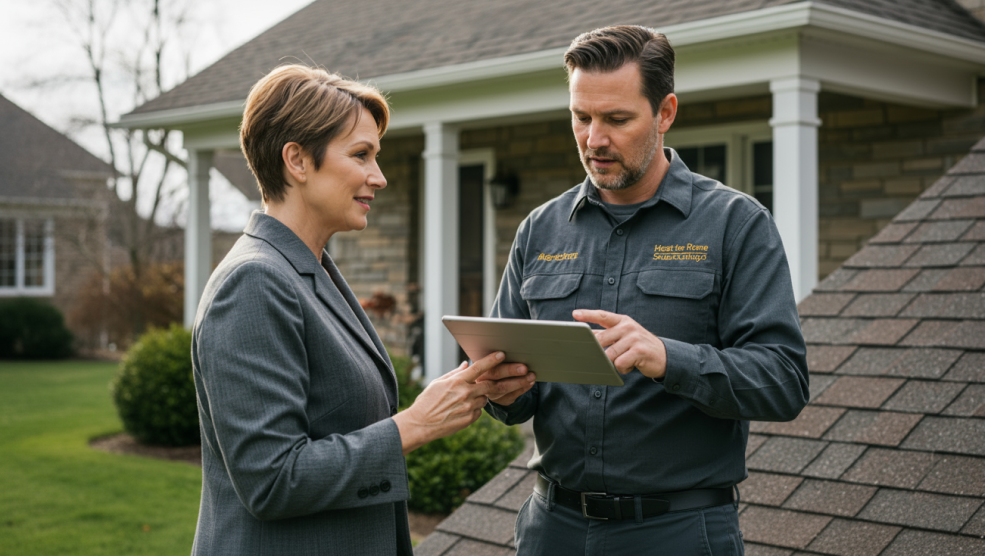Playgrounds are an inherent part of childhood. They create the perfect spot for children to explore, dream, and play. However, this equipment can experience wear and tear over time, and regular maintenance and repairs are critical to ensure the safety of these vibrant hubs. As a parent or guardian, it’s essential to understand the common issues that may affect playground equipment.
Neglecting to maintain equipment appropriately can lead to accidents and serious injuries. Broken swings and worn-out surfaces are just the beginning; making sure everything is in safe working order should be a top priority. Fortunately, you don’t have to be an expert to maintain and repair playground equipment. With the proper knowledge and tools, you can tackle common issues yourself, but for more extensive repairs, you should seek professional help.
In this blog, we’ll provide a comprehensive guide to understanding playground equipment issues. We’ll explore essential safety considerations and common repair scenarios, equipping you with the knowledge needed to determine if you can tackle the repairs yourself or if hiring a professional is the wiser choice. Together, we can make a difference and ensure every child has access to a safe and enjoyable place to play.
Understanding the need for playground safety
A study by the National Program for Playground Safety reveals that regular maintenance and repair can significantly reduce the risk of accidents and injuries. As a parent, caregiver, or someone who cares about children’s safety, it’s crucial to ensure that the local playgrounds remain safe and enjoyable for years.
Before we move into the technical part, let’s take a moment to emphasize the importance of adhering to safety standards, such as ASTM International F1477. These standards encompass everything from the construction and assembly of playground equipment to its functioning as a safe and fun play space. Don’t forget that small repairs that you are tempted to ignore, like worn-out parts, loose bolts, and cracked surfaces, can have potential injury risks. Failing to address these concerns and perform proper maintenance can also lead to liability issues.
The National Program for Playground Safety (NPPS) goes beyond just equipment to create a S.A.F.E. approach to preventing injuries. This approach considers various factors that contribute to a child’s safety on the playground:
S = Supervision
A = Appropriate Environments
F = Fall Surfacing
E = Equipment Maintenance
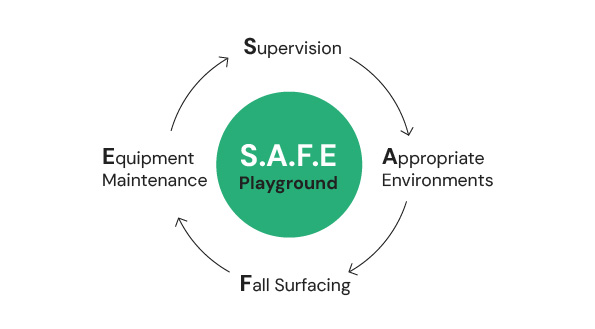
Keep these safety recommendations in mind when your child is on the playground:
- Keep a close eye on your child and make sure they use equipment safely.
- Avoid loose clothing or dangling strings that could get caught.
- Choose equipment designed for your child’s age and abilities.
- Make sure the ground under the equipment is cushioned to absorb falls.
- Report any broken equipment or low levels of cushioning material to the responsible entity (city, county, or school).
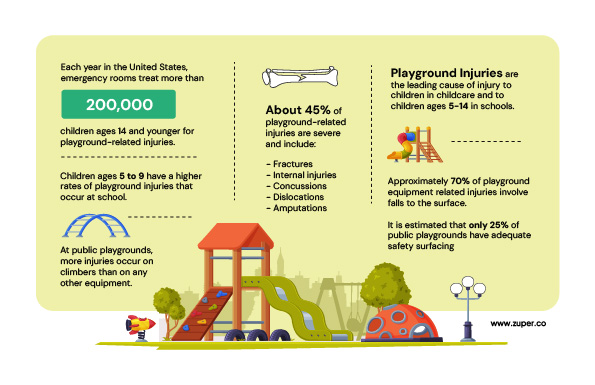
But don’t worry—regular safety inspections by qualified professionals can help identify and address potential hazards before they cause any harm. So, let’s work together to keep those playgrounds safe, fun, and inviting for all children!
Common playground equipment ailments and how to fix them
Playground equipment is there to provide children with a place to play and help them develop physically. However, wear and tear over time can lead to common ailments that compromise the safety of these play structures. Addressing these issues promptly is crucial to prevent accidents and injuries. If you’re a landscape service provider, you must know the common problems that can arise with playground equipment.
Swing set salvation
How to fix a broken swing set?
Check for any loose bolts or nuts that are securing chains and attachments. If you find any, tighten them. If you see any damaged hardware, replace it with high-quality, certified parts. Replace seats with excessive wear, cracks, or splinters. Ensure the new seats meet safety standards and are compatible with your swing set frame. Unfortunately, repairing significant frame damage is often beyond the scope of DIY efforts. If structural repairs are needed to maintain the integrity of the equipment, it’s best to consult a professional.
How do you replace swing chains?
Gather tools like pliers, wrenches, and a swing chain replacement kit. Detach the old chain from the swing set frame and swing seat using the pliers and wrenches. Thread the new chain through the designated openings on the swing seat and frame, following the manufacturer’s instructions. Secure the chain with the provided hardware, ensuring proper tightness and following the manufacturer’s recommended torque specifications.
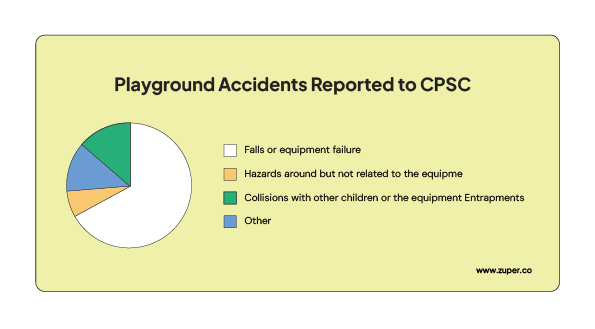
Smooth slide
How to repair a cracked slide
Minor cracks might be repairable using specialized patching materials designed for outdoor use. However, ensuring safety requires professional repair or replacement when extensive cracking or structural damage is present. Sand down rough edges to prevent scrapes and injuries. Consider replacing individual slide sections or the entire slide if necessary for more significant damage. Securely reattach the ladder using the appropriate hardware and ensure bolts and fasteners are tight. If the ladder is damaged beyond repair, replace it with a compatible one.
Climbing frame challengesHow to tighten loose bolts on playground equipment
Locate any loose bolts, then using a wrench or socket tighten them to the manufacturer’s recommended specifications. Replace any damaged or corroded bolts with certified parts, ensuring that the frame remains secure and stable. Fix any worn-out hand holds or rungs, providing a safe gripping surface for children.
Playground surfacing solutions
How to maintain playground surface safety
Rake and turn loose-fill materials like mulch or wood chips to maintain a consistent depth and prevent compaction. Consider adding new material if necessary. Address any gaps or holes promptly to avoid tripping hazards. For loose-fill surfaces, fill the gaps with compatible material.
For poured rubber or other fixed surfaces, consult a professional for repairs. Ensure proper drainage to prevent water from pooling under the surface, which can lead to mold growth and deterioration. Address any drainage problems by consulting a professional to install drainage channels or adjust the surface slope.
DIY vs. Professional repairs
While some minor repairs, like tightening loose bolts or replacing swing seats, can be tackled by untrained individuals with the proper tools, prioritizing safety is paramount. Here’s where the decision between DIY and professional intervention becomes crucial:
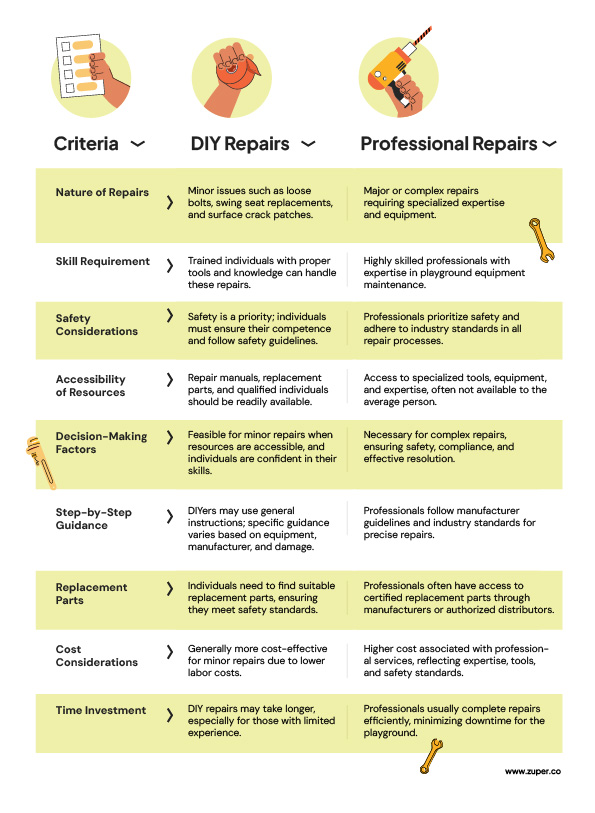
When to consider DIY repairs?
If you’re looking to save some time and money by tackling minor maintenance yourself, DIY repairs are a great option. Whether you need to tighten some loose bolts, replace a swing seat insert, or patch some minor surface cracks, you can probably handle it with the right equipment.
Of course, safety should always come first. If you are hesitant to do a repair yourself because you don’t know how to do it safely, then it’s better to seek professional help. With resources like repair manuals and qualified professionals at your disposal, you don’t have to worry about not being able to address a repair. Make the decision that is right for you and your home, whether it is a DIY solution or employing a professional.
How to find accurate repair instructions for playground equipment?
If you’re looking to find accurate repair instructions for playground equipment, it’s essential to understand that instructions can vary based on factors like:
- The type of equipment,
- Who made it, and
- What kind of damage are you dealing with?
First off, it’s crucial to understand that not all repair scenarios are the same. Different types of playground equipment, from swings to jungle gyms, might need different fixes. Plus, the manufacturer’s instructions for one piece of equipment might not apply to another. So, before starting any repairs, ensure that you understand your situation’s unique characteristics.
So, What should you do to find accurate repair instructions for playground equipment?
Your first stop should be the manufacturer’s manual or website. They’ll have detailed instructions that are specific to the equipment you are working on. Checking the manufacturer’s documentation ensures you get accurate information regarding the design and materials used in the equipment.
If you can’t find what you need from the manufacturer, turn to online resources. Websites like the Consumer Product Safety Commission (CPSC) offer lots of helpful tips and safety guidelines for maintaining and repairing playground equipment.
When to consider professional help?
Sometimes, fixing playground equipment by yourself works fine for small problems. But there are times when it’s better to call in the professionals to make sure everything gets fixed correctly. Knowing when to get help from professionals keeps the playground safe and in good shape. Here’s when you should think about calling in the experts:
1. Structural damage: If you notice big cracks in the mainframe, bent or broken support beams, or problems with the playground’s foundation, it’s best to call a professional. These kinds of issues need immediate attention to keep kids safe, and professionals are trained to handle them.
2. Electrical or Mechanical Problems: Some playgrounds have electrical or mechanical parts, like motorized rides. Fixing these can be tricky and dangerous if you don’t know what you’re doing. Electricians or technicians who know about playgrounds should handle these kinds of repairs.
3. Specialized Equipment: Certain playground equipment, like zip lines or climbing walls, need specialized tools and skills to repair them correctly. Professionals who are used to working with these kinds of equipment can safely do the job quickly and efficiently.
4. Manufacturer’s Recommendations: If the folks who made the playground say you need a professional to install or fix something, it’s smart to listen. They know their equipment best, and sometimes, warranties depend on getting licensed professionals to complete the repair.
5. Safety Rules: Public playgrounds need to follow certain safety rules. Prefessionals know these rules and can make sure repairs are performed correctly, keeping everyone safe.
6. Tough Repairs: If a repair seems too hard or complicated for you to handle, it’s okay to ask for help. Professionals have the training and experience to deal with even the trickiest repairs.
7. Limited Time or Resources: When you’re short on time or tools, calling in a professional can be a big help. They’ve got what they need to get the job done quickly while causing minimal disruption.
Streamlining playground repair operations with a field service management (FSM) solution
Implementing an FSM solution can significantly improve efficiency and streamline repair operations for organizations responsible for managing multiple playgrounds or extensive equipment portfolios.
These software solutions offer a range of features designed to:
1. Optimize scheduling and dispatch
FSM systems excel in efficiently scheduling repair appointments. They consider location, workload, and expertise to allocate appropriate repair time slots. The solution facilitates intelligent dispatching by sending technicians to locations based on their proximity, expertise, and workload. This ensures a strategic utilization of resources and minimizes travel time. By optimizing scheduling and dispatch, FSM systems contribute to efficient resource utilization, reducing downtime and improving the overall responsiveness of repair operations.
2. Real-time tracking and communication
FSM solutions provide real-time tracking of technician locations. This feature enables better visibility into field activities, allowing the central office to monitor progress and respond promptly to changes or challenges. The system fosters clear communication channels between field personnel and the central office. Instant updates on job statuses, challenges, or additional requirements ensure a streamlined flow of information. Real-time tracking and communication significantly enhance the efficiency of repair operations by minimizing delays, improving coordination, and providing a proactive response to emerging issues.
3. Mobile tools and digital forms
FSM solutions equip technicians with mobile apps for managing work orders, conducting inspections, and submitting reports. This not only improves efficiency but also enhances data accuracy and collection. Mobile tools and digital forms streamline the entire repair process, from initial inspection to completion, reducing paperwork and ensuring that information is readily available and accessible. By utilizing mobile tools, organizations can efficiently collect and update data in real-time, leading to more accurate records and facilitating data-driven decision-making.
4. Inventory management
FSM solutions facilitate the tracking and managing of inventory levels for replacement parts and equipment. This ensures that necessary components are readily available, preventing delays in the repair process. Organizations can implement preventive maintenance strategies by having a comprehensive view of inventory levels, ensuring that essential parts are in stock before issues arise. Efficient inventory management contributes to cost savings by minimizing the need for emergency orders and preventing unnecessary downtime due to the unavailability of parts.
5. Improved reporting and analysis
FSM systems provide insights into repair trends, allowing organizations to identify recurring issues and implement targeted solutions. The software generates comprehensive reports for record-keeping and compliance purposes, offering a detailed overview of repair operations, resource utilization, and overall performance. Improved reporting and analysis empower organizations to make informed and strategic decisions, optimizing their repair processes and resource allocation.
Conclusion
Playgrounds are vital for childhood development, but safety is paramount. Regular maintenance and repairs are crucial to prevent accidents. This guide equips you with the knowledge to tackle common repairs yourself or when to seek professional help. Remember, safety comes first! Don’t hesitate to call in a professional for extensive repairs. Together, we can make a difference! By prioritizing safety and working collaboratively—parents, caregivers, professionals, and organizations—we can ensure playgrounds remain fun and safe havens for all children.
